| |

| Author |
Topic Options
|

 Posts:
Posts: 51947
 Posted: Posted: Mon Apr 27, 2020 6:27 am
$1: Long-Lost U.S. Military Satellite Found By Amateur Radio Operator
There are more than 2,000 active satellites orbiting Earth. At the end of their useful lives, many will simply burn up as they reenter the atmosphere. But some will continue circling as "zombie" satellites — neither alive nor quite dead.
"Most zombie satellites are satellites that are no longer under human control, or have failed to some degree," says Scott Tilley.
Tilley, an amateur radio operator living in Canada, has a passion for hunting them down.
In 2018, he found a signal from a NASA probe called IMAGE that the space agency had lost track of in 2005. With Tilley's help, NASA was able to reestablish contact.
But he has tracked down zombies even older than IMAGE.
"The oldest one I've seen is Transit 5B-5. And it launched in 1965," he says, referring to a nuclear-powered U.S. Navy navigation satellite that still circles the Earth in a polar orbit, long forgotten by all but a few amateurs interested in hearing it "sing" as it passes overhead.
Recently, Tilley got interested in a communications satellite he thought might still be alive — or at least among the living dead. LES-5, built by the Massachusetts Institute of Technology's Lincoln Laboratory, was launched in 1967.
Tilley was inspired by another amateur who in 2016 had found LES-1, an earlier satellite built by the same lab. What was intriguing to him about LES-5 was that if it was still working, it might be the oldest functioning satellite still in geostationary orbit.
https://www.npr.org/2020/04/24/84349330 ... o-operator
|

 Posts:
Posts: 51947
 Posted: Posted: Mon Apr 27, 2020 6:58 am
$1: Starship chilled. Starship pressurized. And for the first time, it didn’t explode Late on Sunday night, SpaceX completed a critical cryogenic test of a Starship prototype at its launch site in South Texas. The successful test, during which chilled nitrogen was loaded into pressurized fuel tanks, was reported on Twitter by SpaceX founder Elon Musk. The vehicle, dubbed SN4—which stands for Serial Number 4—was pressurized to 4.9 bar, or 4.9 times the atmospheric pressure at the surface of the Earth. This pressure is not as high as Starship's fuel tanks and plumbing system are designed to withstand, but it is enough for a basic flight. This marks an important moment in the Starship program. Since November 2019, the company has lost three full-scale Starship prototypes during cryogenic and pressure tests. The most recent failure came on April 3. This is the first time a vehicle has survived pressure testing to advance to further work. Such tests are designed to ensure the integrity of a rocket's fueling system prior to lighting an engine. Now, Musk said, SpaceX engineers will attach a single Raptor engine to this vehicle and conduct a static fire test. The company hopes to move forward with this test later in the week. Should the static fire test be successful, Musk has said the SN4 vehicle will make a 150-meter "hop" test, much as the "Starhopper" prototype performed in August 2019. The company has yet to receive regulatory approval for this test, so it may not happen for several weeks. https://arstechnica.com/science/2020/04 ... meter-hop/
|

 Posts:
Posts: 51947
 Posted: Posted: Thu Apr 30, 2020 5:46 am
$1: Hubble captures breakup of comet ATLAS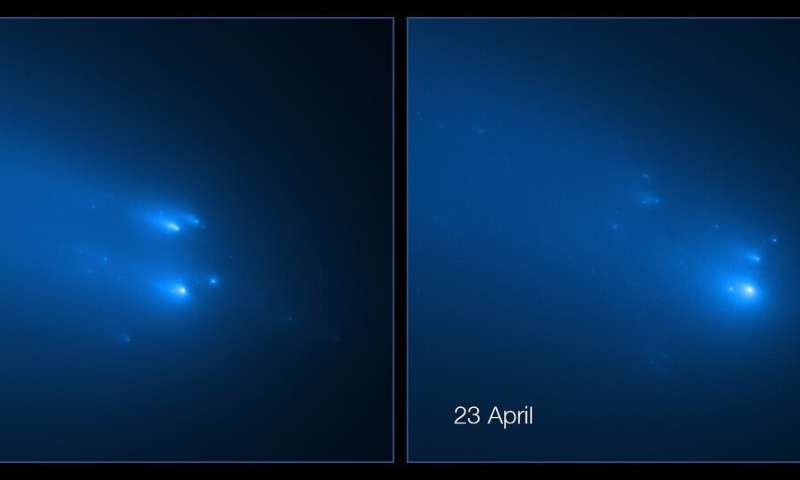 $1: The NASA/ESA Hubble Space Telescope has provided astronomers with the sharpest view yet of the breakup of Comet C/2019 Y4 (ATLAS). The telescope resolved roughly 30 fragments of the comet on 20 April and 25 pieces on 23 April. Credit: NASA, ESA, D. Jewitt (UCLA), Q. Ye (University of Maryland) The NASA/ESA Hubble Space Telescope has provided astronomers with the sharpest view yet of the breakup of Comet C/2019 Y4 (ATLAS). The telescope resolved roughly 30 fragments of the fragile comet on 20 April and 25 pieces on 23 April. The comet was first discovered in December 2019 by the ATLAS (Asteroid Terrestrial-impact Last Alert System) robotic astronomical survey system in Hawaii, USA. It brightened quickly until mid-March, and some astronomers initially anticipated that it might be visible to the naked eye in May to become one of the most spectacular comets seen in the last two decades. However, the comet abruptly began to get dimmer, leading astronomers to speculate that the icy core may be fragmenting, or even disintegrating. ATLAS's fragmentation was confirmed by amateur astronomer Jose de Queiroz, who photographed around three pieces of the comet on 11 April. The Hubble Space Telescope's new observations of the comet's breakup on 20 and 23 April reveal that the broken fragments are all enveloped in a sunlight-swept tail of cometary dust. These images provide further evidence that comet fragmentation is probably common and might even be the dominant mechanism by which the solid, icy nuclei of comets die. https://phys.org/news/2020-04-hubble-ca ... atlas.html
|

 Posts:
Posts: 51947
 Posted: Posted: Thu Apr 30, 2020 9:12 am
$1: Dancing gargantuan black holes perform on cue Astronomers have been able to test key consequences of Einstein's theories by studying the way a couple of black holes move around each other. One of these objects is a true colossus - a hole weighing 18 billion times the mass of our Sun; the other not quite so big at "only" 150 million Sun masses. Scientists managed to predict their interactions very precisely. They did so by including their warping effects on space-time and by assuming the larger hole had a smooth "surface". The black hole pairing, known as OJ 287, exists about 3.5 billion light-years from Earth. Scientists have long recognised a sudden brightening from this system that occurs twice every 12 years. The outburst of energy is equivalent to a trillion suns turning on at once in the holes' host galaxy. The best explanation for this extraordinary behaviour is that the smaller object is routinely crashing through a disc of gas and dust that's accreting on to its larger companion, heating the inspiraling material to extremely high temperatures in the process. But this flaring is somewhat irregular. Sometimes the brightening episodes in the 12-year period occur as little as one year apart; other times, as much as 10 years apart.  It speaks to the complexity of the path the small hole takes around its partner - a complexity the research team has now built into a highly sophisticated model. https://www.bbc.com/news/amp/science-en ... t-52464250
|

 Posts:
Posts: 51947
 Posted: Posted: Thu Apr 30, 2020 11:48 am
$1: NASA awards lunar lander contracts to Blue Origin, Dynetics—and Starship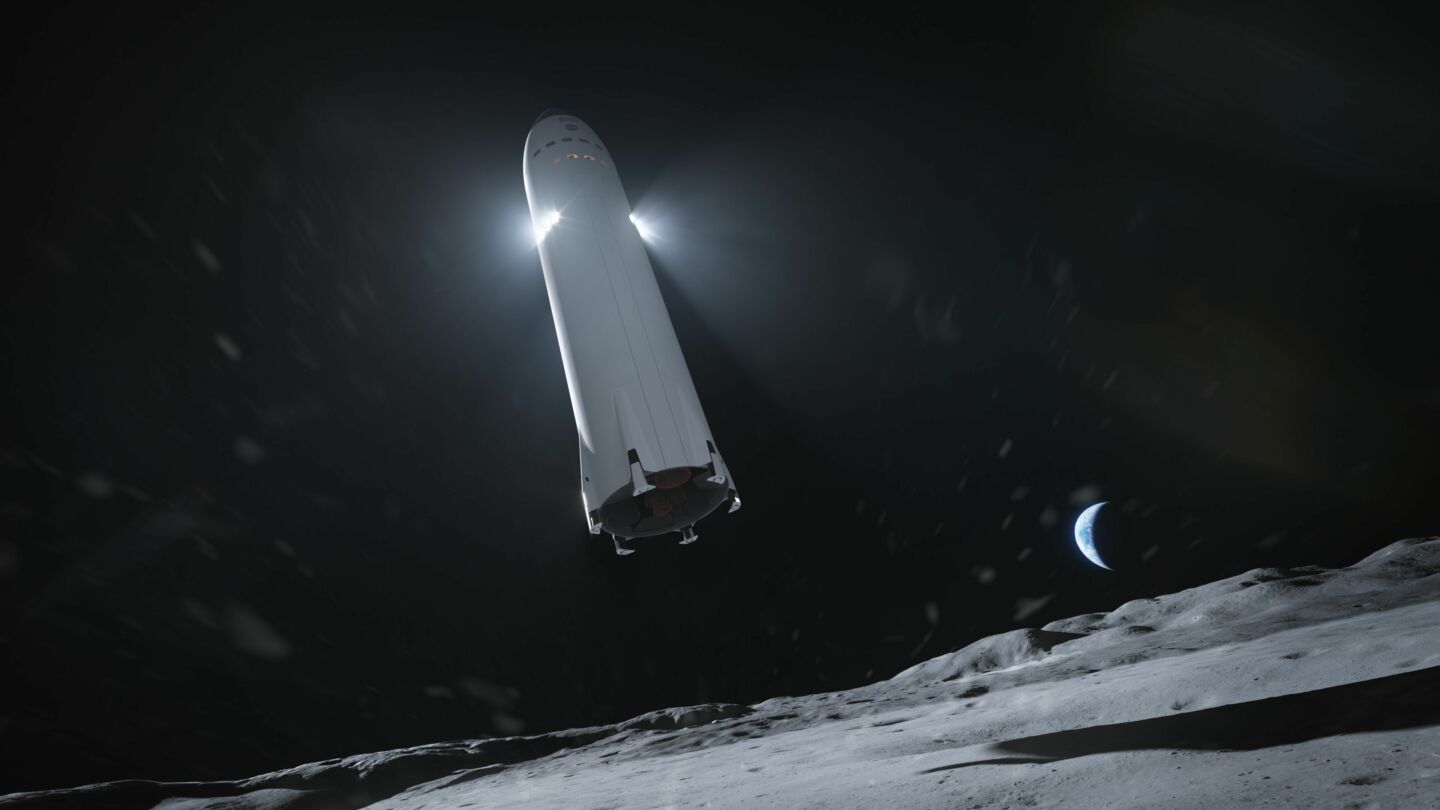 $1: SpaceX's Starship vehicle is seen landing on the Moon. NASA announced Thursday that it has awarded three contracts to begin initial development of lunar landing systems that will take astronauts down to the surface of the Moon in less than five years. With these Human Landing System awards, space agency officials reiterated in an interview that they remain committed to landing a pair of astronauts on the Moon by 2024 and building a sustainable presence by 2028. Asked if 2024 was still "on the table" despite the COVID-19 pandemic and myriad other challenges with such an aggressive timeline, NASA's chief of human spaceflight, Doug Loverro, replied, "It's not only on the table, it is the table." The awards are notable both for their diversity and NASA's apparent willingness to take a chance on SpaceX and its out-of-the-box concept with its ambitious Starship system. "Between the three contractors I think NASA has everything it needs to be successful for the 2024 landing, and not just that, we have what is necessary for a sustainable lunar presence by 2028," NASA Administrator Jim Bridenstine told Ars. "We’re thrilled. Each one of these contractors brings not just unique designs, they’re bringing unique histories and unique philosophies toward development. All of that makes NASA better." https://arstechnica.com/science/2020/04 ... -starship/
|

 Posts:
Posts: 51947
 Posted: Posted: Tue May 05, 2020 9:48 am
$1: Radio burst inside Milky Way may give clues about fast radio bursts Radio observatories around the world have reported capturing a unique event—a strong, millisecond-long burst of radio waves coming from a type of neutron star inside the Milky Way. Because of its strength, space scientists are hoping that further study will show that it was a fast radio burst (FRB) emanating from within our own galaxy—if so, a great mystery might soon be solved—their source. FRBs are quick pulses of strong radio waves that have been detected by radio observatories around the world—the first was recorded back in 2001. Since that time, many more have been recorded (most of which never repeat), but scientists have not been able to explain their source. In recent years, many in the field have speculated that they are generated by magnetars—a special type of neutron star with an unusually strong magnetic field. They may generate FRBs, researchers have suggested, when the balance between their magnetic field and their gravitational force leads to super-strong starquakes followed by massive magnetar flares. To date, the FRBs that have been observed have come from a source that was so far away that it was impossible to tell if they were being generated by magnetars, much less by their strong quakes. So this new powerful radio burst has generated much excitement. Not only did it come from an identifiable magnetar (SGR 1935+2154), but it was close enough for researchers at radio observatories to also measure the X-ray counterpart of the burst—something previously impossible with FRBs. https://phys.org/news/2020-05-radio-mil ... -fast.html
|

 Posts:
Posts: 51947
 Posted: Posted: Tue May 05, 2020 9:49 am
Magnetars are cool. 
|

 Posts:
Posts: 51947
 Posted: Posted: Wed May 06, 2020 8:27 am
$1: Astronomers find closest black hole to Earth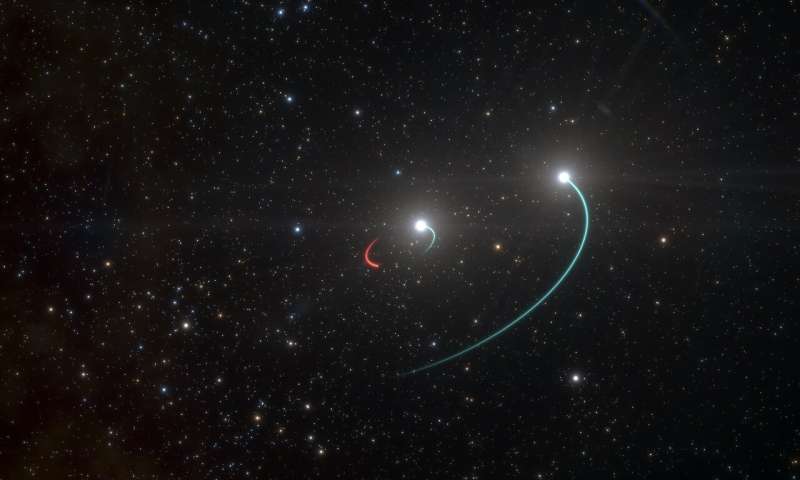 $1: This artist's impression shows the orbits of the objects in the HR 6819 triple system. This system is made up of an inner binary with one star (orbit in blue) and a newly discovered black hole (orbit in red), as well as a third star in a wider orbit (also in blue).The team originally believed there were only two objects, the two stars, in the system. However, as they analysed their observations, they were stunned when they revealed a third, previously undiscovered body in HR 6819: a black hole, the closest ever found to Earth. The black hole is invisible, but it makes its presence known by its gravitational pull, which forces the luminous inner star into an orbit. The objects in this inner pair have roughly the same mass and circular orbits.The observations, with the FEROS spectrograph on the 2.2-metre telescope at ESO's La Silla, showed that the inner visible star orbits the black hole every 40 days, while the second star is at a large distance from this inner pair. Credit: ESO/L. Calçada
A team of astronomers from the European Southern Observatory (ESO) and other institutes has discovered a black hole lying just 1000 light-years from Earth. The black hole is closer to our Solar System than any other found to date and forms part of a triple system that can be seen with the naked eye. The team found evidence for the invisible object by tracking its two companion stars using the MPG/ESO 2.2-metre telescope at ESO's La Silla Observatory in Chile. They say this system could just be the tip of the iceberg, as many more similar black holes could be found in the future. "We were totally surprised when we realised that this is the first stellar system with a black hole that can be seen with the unaided eye," says Petr Hadrava, Emeritus Scientist at the Academy of Sciences of the Czech Republic in Prague and co-author of the research. Located in the constellation of Telescopium, the system is so close to us that its stars can be viewed from the southern hemisphere on a dark, clear night without binoculars or a telescope. "This system contains the nearest black hole to Earth that we know of," says ESO scientist Thomas Rivinius, who led the study published today in Astronomy & Astrophysics. The team originally observed the system, called HR 6819, as part of a study of double-star systems. However, as they analysed their observations, they were stunned when they revealed a third, previously undiscovered body in HR 6819: a black hole. The observations with the FEROS spectrograph on the MPG/ESO 2.2-metre telescope at La Silla showed that one of the two visible stars orbits an unseen object every 40 days, while the second star is at a large distance from this inner pair. https://phys.org/news/2020-05-astronome ... earth.html
|

 Posts:
Posts: 51947
 Posted: Posted: Wed May 06, 2020 8:57 am
$1: SpaceX has fired Starship’s Raptor engine, and the vehicle still stands For the first-time, a full-scale prototype of SpaceX's Starship vehicle lit its engine on Tuesday evening. After ignition, it appeared that the Raptor rocket engine burned for about 4 seconds. At the end of this test at the South Texas Launch Site, the vehicle still stood. About 90 minutes after the test, SpaceX founder and Chief Engineer Elon Musk confirmed the test firing was good, saying, "Starship SN4 passed static fire." Tuesday night's test, which took place at 8:57pm CT local time in Texas (01:57 UTC Wednesday), occurred eight days after a successful pressurization test of this Starship prototype, known as SN4. Engineers will now review the data before possibly performing another static fire test, or a small hop. Ultimately, if this vehicle survives additional testing, it may make a 150-meter hop above the scrubby Texas lowlands. This test also took place less than a week after NASA awarded SpaceX a $135 million contract to develop Starship as a Lunar Lander—a vehicle for carrying cargo and crew from lunar orbit down to the surface and back. Although Starship is the most ambitious of three landers NASA is considering as part of its Artemis Program, it is also the only one actively testing full-scale prototypes. Last August SpaceX flew a stubby vehicle dubbed Starhopper with a single Raptor engine. The goal of this vehicle was to test basic plumbing for the Raptor engine and to see if its flight could be controlled for a safe ascent and descent. Although the Starhopper made a hard landing, it survived this test, and SpaceX moved on to build a full-scale prototype of Starship. Since November 2019, the company has lost three full-scale Starship prototypes during cryogenic and pressure tests. The most recent failure came on April 3. SN4 is the first vehicle to survive pressure testing to advance to further work. Now it has taken the critical step of igniting at liftoff pressures—a stiff test given the challenges of working with super-chilled fuels at high pressure—and then safely shutting down. https://arstechnica.com/science/2020/05 ... ll-stands/
|

 Posts:
Posts: 51947
 Posted: Posted: Thu May 07, 2020 9:47 am
$1: The mysterious yellow skies of WASP-79b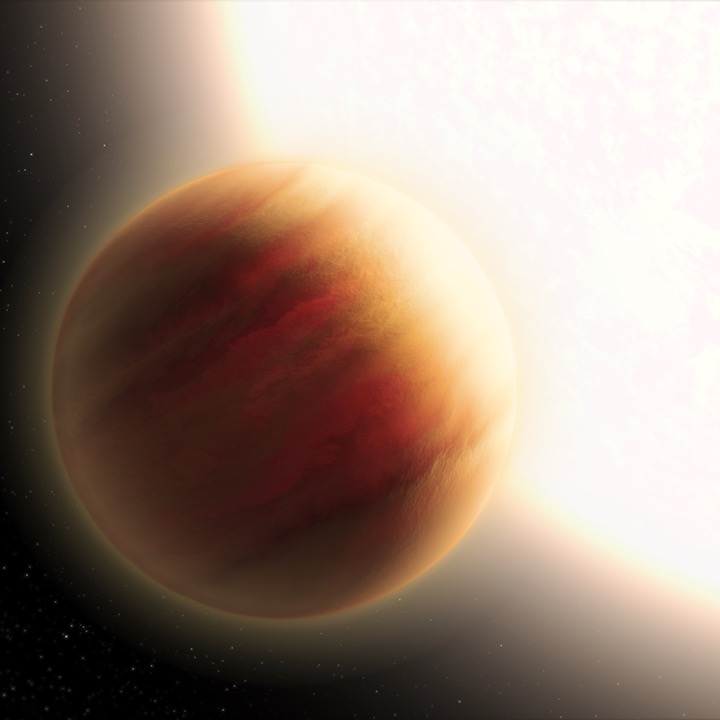 $1: Artist’s concept of WASP-79b, a hot Jupiter-like exoplanet 780 light-years from Earth. New research shows the planet has a yellow sky instead of blue as expected. Image via NASA/ ESA/ L. Hustak (STScI)/ Hubblesite. Earth is beautiful, and we might sometimes take it for granted that we can look up and see a deep blue sky. But what about other planets? A planet’s particular sky depends, of course, on its unique atmosphere. For example, we here on Earth have a blue sky because the blue component of our sun’s light is scattered in all directions by air molecules in Earth’s atmosphere. Mars, on the other hand, has a more pinkish sky due to ever-present dust lofted from Mars surface by winds. Now, scientists have announced results of a study of a distant exoplanet, orbiting a star hotter and brighter than our sun. This planet – called WASP-79b – doesn’t have a blue or pink sky, but instead a yellow one! The finding was made by researchers combining data from the Hubble Space Telescope, the Transiting Exoplanet Survey Satellite (TESS) and the ground-based Magellan telescopes at the Las Campanas Observatory in Chile. The intriguing results were first published December 10, 2019, in The Astrophysical Journal and later published in the January 2020 issue of the journal. WASP-79b is a large gas giant planet of the type known as a hot Jupiter, which orbits very close to its star and completes an orbit in only 3 1/2 days. Its star, WASP-79, is about 780 light-years away in the constellation Eridanus the River. Scientists had expected that the planet would experience Rayleigh scattering, where certain colors of light are dispersed by very fine dust particles in the upper atmosphere. This is what makes Earth’s skies blue, since shorter (bluer) wavelengths of sunlight are dispersed. 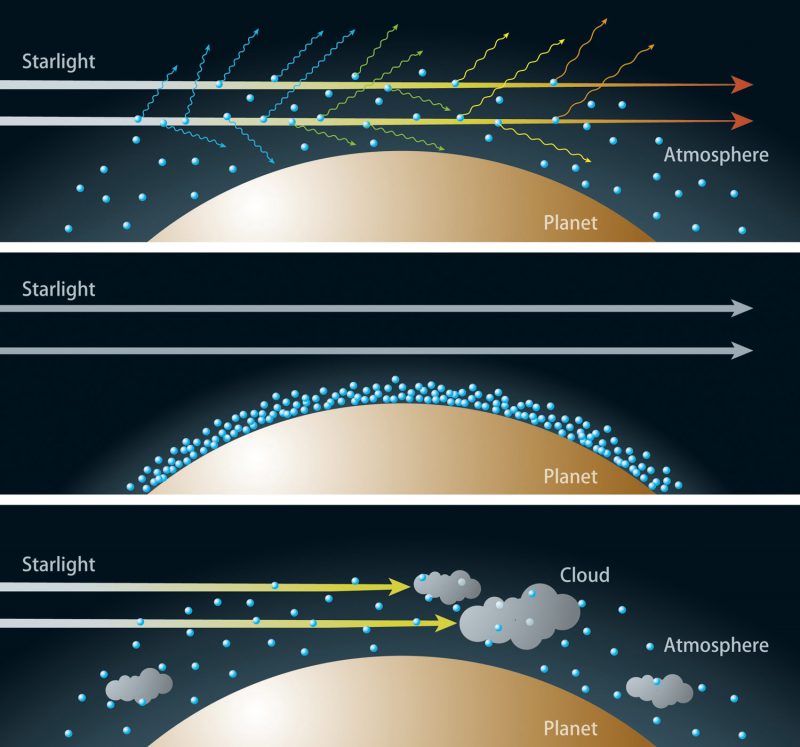 $1: Schematic of an exoplanet atmosphere in relation to the visible light that passes through it. Top: cloudless, distended atmospheres (top) scatter mostly blue light through Rayleigh scattering, while longer wavelengths like red light pass through. Bottom: cloudy atmospheres equally prevent all wavelengths of visible light from passing through. Middle: if the atmosphere is less extended and cloudless, all visible light passes through about equally. Image via National Astronomical Observatory of Japan/ JHUAPL. https://earthsky.org/space/wasp-79b-exo ... scattering
|

 Posts:
Posts: 51947
 Posted: Posted: Fri May 08, 2020 9:54 am
$1: Incredible video shows Hayabusa2 pogo-bouncing off asteroid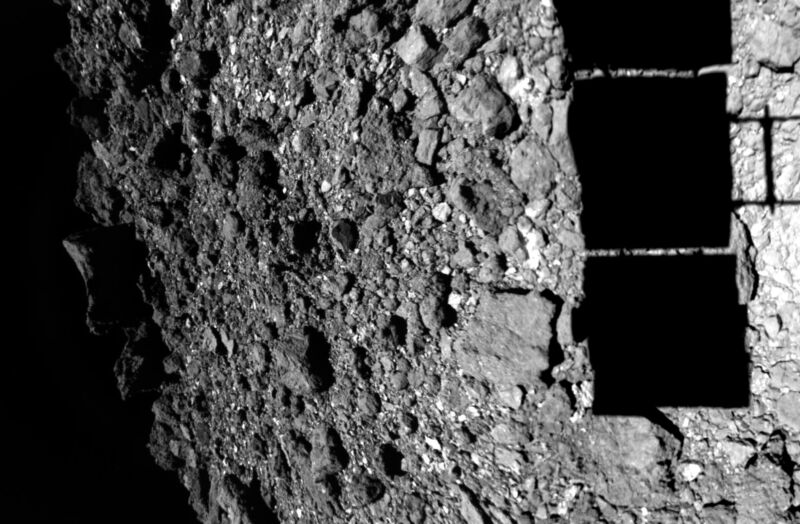 The following series of events is not fiction: fly a probe to an asteroid, bounce off that asteroid while grabbing a piece of it, and fling that sample back to Earth. This series of activities is exactly what JAXA’s Hayabusa2 mission is in the middle of doing. (And by the way, NASA’s OSIRIS-REx mission is working on the exact same thing, just on a timeline a year behind Hayabusa2.) Hayabusa2 grabbed its first sample from the surface of a near-Earth asteroid named Ryugu in February 2019. (A second sample was collected in July after it blasted a small crater to expose sub-surface material.) A new study published by the team this week details what the probe saw at the sampling site—including remarkable video of the touchdown itself. We have touchdownAs the probe touched Ryugu’s surface, it fired a small projectile into it, catching some of the debris in an open “sampling horn” before bouncing away and re-establishing its orbit. These samples will return to the Earth later this year, but for now, the scientists are establishing what we know about the areas they came from. Ryugu has a somewhat angular shape and is a little less than a kilometer across, and its equator bulges out in a distinctive ridge that makes the asteroid resemble a spinning top. Up close, it looks like a rubble pile. But there are some interesting color patterns within that jumble. https://arstechnica.com/science/2020/05 ... -asteroid/
|

 Posts:
Posts: 51947
 Posted: Posted: Fri May 08, 2020 9:55 am
$1: Gemini gets lucky and takes a deep dive into Jupiter's clouds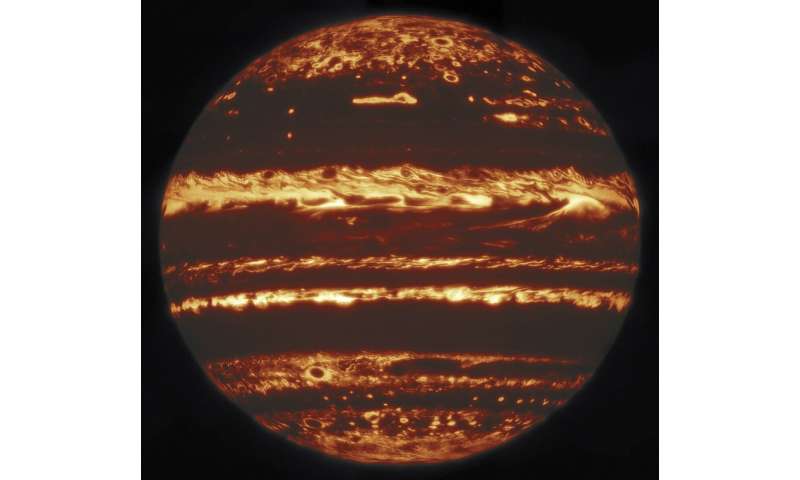 $1: This image showing the entire disk of Jupiter in infrared light was compiled from a mosaic of nine separate pointings observed by the international Gemini Observatory, a program of NSF's NOIRLabon 29 May 2019. From a "lucky imaging" set of 38 exposures taken at each pointing, the research team selected the sharpest 10%, combining them to image one ninth of Jupiter's disk. Stacks of exposures at the nine pointings were then combined to make one clear, global view of the planet. Even though it only takes a few seconds for Gemini to create each image in a lucky imaging set, completing all 38 exposures in a set can take minutes -- long enough for features to rotate noticeably across the disk. In order to compare and combine the images, they are first mapped to their actual latitude and longitude on Jupiter, using the limb, or edge of the disk, as a reference. Once the mosaics are compiled into a full disk, the final images are some of the highest-resolution infrared views of Jupiter ever taken from the ground. Credit: International Gemini Observatory/NOIRLab/NSF/AURA, M.H. Wong (UC Berkeley) and team Acknowledgments: Mahdi Zamani Researchers using a technique known as "lucky imaging" with the Gemini North telescope on Hawaii's Maunakea have collected some of the highest resolution images of Jupiter ever obtained from the ground. These images are part of a multi-year joint observing program with the Hubble Space Telescope in support of NASA's Juno mission. The Gemini images, when combined with the Hubble and Juno observations, reveal that lightning strikes, and some of the largest storm systems that create them, are formed in and around large convective cells over deep clouds of water ice and liquid. The new observations also confirm that dark spots in the famous Great Red Spot are actually gaps in the cloud cover and not due to cloud color variations. Three years of imaging observations using the international Gemini Observatory, a program of NSF's NOIRLab, have probed deep into Jupiter's cloud tops. The ultra-sharp Gemini infrared images complement optical and ultraviolet observations by Hubble and radio observations by the Juno spacecraft to reveal new secrets about the giant planet. "The Gemini data were critical because they allowed us to probe deeply into Jupiter's clouds on a regular schedule," said Michael Wong of UC Berkeley. "We used a very powerful technique called lucky imaging," adds Wong. With lucky imaging, a large number of very short exposure images are obtained and only the sharpest images, when the Earth's atmosphere is briefly stable, are used. The result in this case is some of the sharpest infrared images of Jupiter ever obtained from the ground. According to Wong, "These images rival the view from space." https://phys.org/news/2020-05-gemini-lu ... louds.html
|

 Posts:
Posts: 35256
 Posted: Posted: Fri May 08, 2020 10:43 am
$1: Gemini gets lucky Too bad I'm Cancer. 
|

 Posts:
Posts: 51947
 Posted: Posted: Mon May 11, 2020 10:38 am
$1: A multilayer haze system on Saturn's hexagon
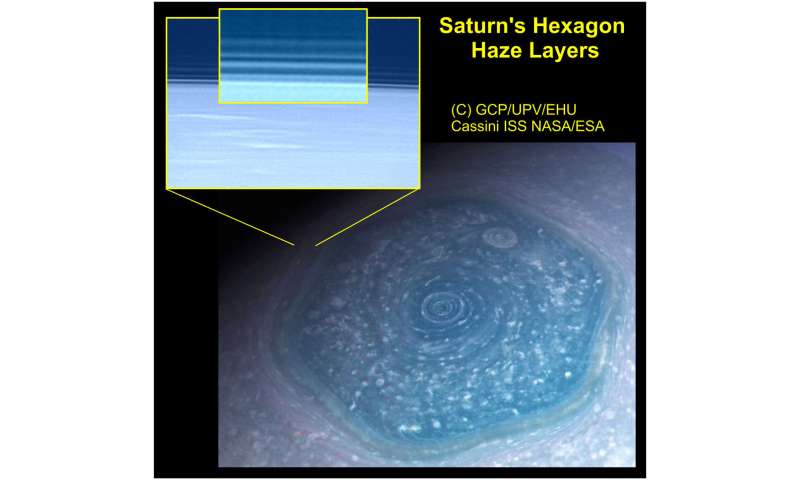 A rich variety of meteorological phenomena takes place in the extensive hydrogen atmosphere of Saturn, a world about 10 times the size of the Earth. They help us to better understand similar features in the Earth's atmosphere. Among Saturn's atmospheric phenomena is the well-known "hexagon," an amazing wave structure that surrounds the planet's polar region. Discovered in 1980 by NASA's Voyager 1 and 2 spacecraft, it has been observed without interruption since then, despite the planet's long, strong cycle of seasons. A fast, narrow jet stream flows inside this gigantic planetary wave where winds reach maximum speeds of about 400 km/h. Yet, strangely enough, the wave itself remains almost static; in other words, it barely shifts with respect to the planet's rotation. All these properties mean that the "hexagon" is a highly attractive phenomenon for meteorologists and planet atmosphere researchers. Cassini, which was in orbit around the planet between 2004 and 2017, took a large quantity of images from a range of distances from the planet and viewing angles. In June 2015, its main camera obtained very high-resolution images of the planet's limb, which are capable of resolving details of between 1 and 2 km; they captured the haze located above the clouds of the hexagonal wave. In addition, they used many colour filters, from ultraviolet to near infrared, thus allowing researchers to study the composition of the haze. To complete this study, the researchers incorporated images produced by the Hubble Space Telescope taken 15 days later and showing the hexagon from above. "The Cassini images have enabled us to discover that, just like a sandwich, the hexagon has a multi-layered system of at least seven mists that extend from the summit of its clouds to an altitude of more than 300 km above them," said Professor Agustín Sánchez-Lavega, who led the study. "Other cold worlds, such as Saturn's satellite Titan or the dwarf planet Pluto, also have layers of haze, but not in such numbers nor as regularly spaced out." https://phys.org/news/2020-05-multilaye ... xagon.html
|

 Posts:
Posts: 51947
 Posted: Posted: Tue May 12, 2020 10:41 am
$1: A Giant Piece of a Chinese Rocket Just Smashed Down to Earth in an Uncontrolled Fall  The remains of a giant segment of a Chinese rocket crash-landed in the Atlantic Ocean this week, representing the most significant uncontrolled descent of a piece of human-made space debris in decades. The core stage of a Chinese Long March 5B (CZ–5B) rocket, which was successfully launched on May 5, spent several days in orbit as part of its mission, before re-entering Earth's atmosphere and falling to Earth, splashing down in ocean waters off the west coast of Mauritania in northwest Africa. The descent, which was eventually confirmed by the 18th Space Control Squadron, a unit of the US Air Force, was notable not just for its huge mass, but also for the extent of the window of uncontrolled descent, which had space-object trackers guessing just where and when the out-of-control rocket would eventually land. "At 17.8 tonnes, it is the most massive object to make an uncontrolled reentry since the 39-tonne Salyut–7 in 1991, unless you count OV–102 Columbia in 2003," tweeted astronomer Jonathan McDowell from the Harvard-Smithsonian Centre for Astrophysics. While the de-orbiting of the CZ–5B rocket might have been uncontrolled, it was not unplanned. Throughout history, space launches have entailed vast amounts of spacecraft and components re-entering Earth's atmosphere as debris, sometimes in controlled or partially controlled manoeuvres, but often in uncontrolled descents. https://www.sciencealert.com/uncontroll ... in-decades
|
 
|
Page 172 of 237
|
[ 3541 posts ] |
Who is online |
Users browsing this forum: No registered users and 1 guest |

|
|

